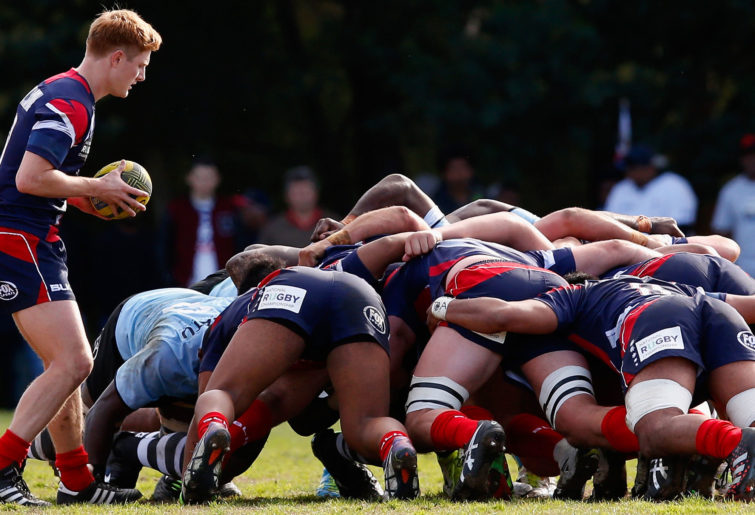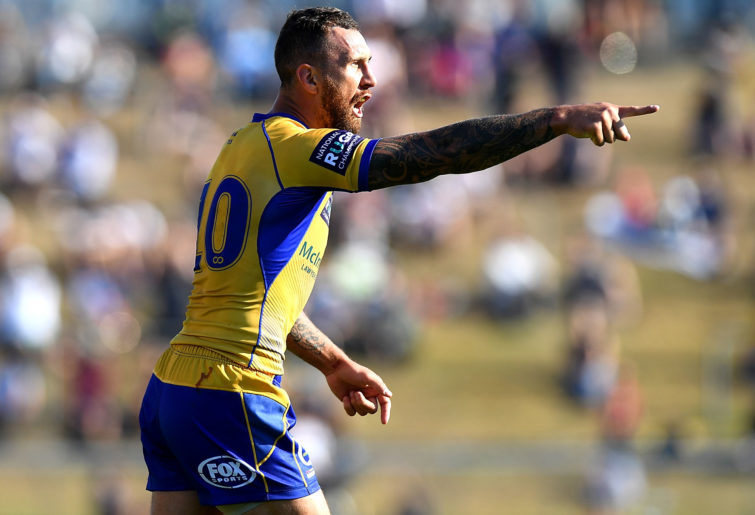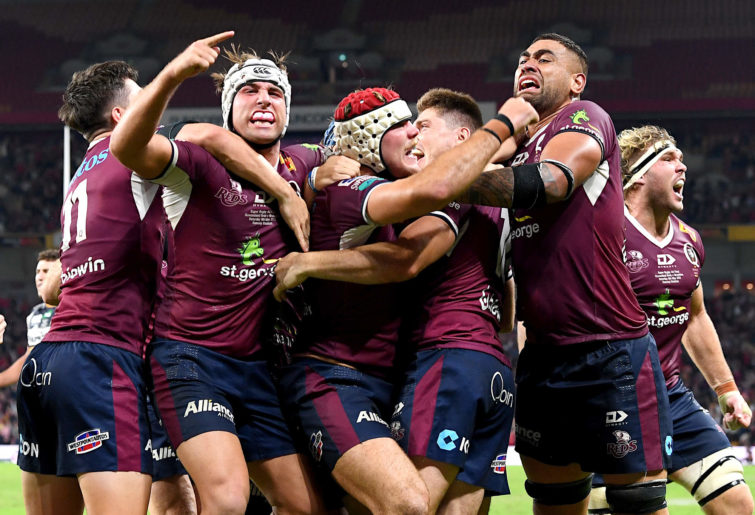Australian rugby is on the move, in every sense of the word. But where it is moving to is the critical question.
Following the news that Phil Waugh is looking into creating a crossover club competition involving the Shute Shield and Hospital Cup, I decided to sit down to write this duology of articles covering, in my opinion, one of the most critical topics in Australian rugby right now.
Yesterday, in part one, I discussed that before we can have any discussion on this competition, we need to come to an agreed sense of the purpose of our third tier. From many of the comments in reaction to the article, the purpose of the third tier is something many fans do NOT agree on. I’m not surprised to see such a reaction.

Nicholas Stirzaker of Melbourne prepares for the scrum feed during the round two NRC match between Melbourne and Fiji at Harlequins Rugby Club on September 9, 2017 in Melbourne, Australia. (Photo by Darrian Traynor/Getty Images)
Is it a pure development pathway? Is it aiming to engage fans? Not to mention, once we have an agreement on the third tier’s purpose, how do we pay for the damn thing?
Now, full disclosure, this is a complex topic, and I’m one bloke floating in a sea of opinions about the third tier. I start by saying that these options below are my opinions, and I welcome discussion on it. I have been extremely lucky to have covered multiple premier grade competitions nationwide for a few years at this point (in addition to the NRC), so I hope that these suggestions and my thoughts on them come from the background of seeing what already exists in the Australian rugby landscape.
I know I’m not the only one thinking about this, following news on Monday that the Brumbies are embarking on a two match tour of Japan, following the Western Force’s lead after they announced in April a four match tour against the Cheetahs in South Africa.
“We identified early last year that without a formalised development competition in Australia, we needed to explore other options and this tour will provide the players and our staff a critical development opportunity but also an enriching cultural experience,” highlighted Brumbies coach Stephen Larkham in Monday’s announcement.
With our professional arm already looking at other options, for me there are three options forward for Australian rugby.
None of these solutions are perfect, but each aims to try and address the two key challenges mentioned earlier: either serve as a development pathway or as a means to attract fans, plus also address the key hurdle of funding.

Rhian Stowers in action for Bond University (Photo by Stephen Tremain)
Option One: An Australian Club Competition
The option that Phil Waugh is currently looking at, the focus of this competition would be premier grade clubs. While the details of such a competition are unclear, the premise would be that the best of the Shute Shield would go toe-to-toe with the best of the Hospital Cup.
On paper, it makes sense: despite the growth in other interstate competitions, the vast majority of Australia’s players still come out of these two states. These are established premier grade club systems with decades of history in their respective competitions, established support with several Super Rugby sides, and a connection to local communities.
Many players who play in these teams still go on to higher honours like the Wallabies, which would further connect fans with our national team. The site of seeing Quade Cooper playing for Souths or James O’Connor at Brothers was huge for community fans. For those clubs involved, it would be a huge positive, extending professional players’ game time past the end of the club rugby season in August/September.
Realistically speaking, a club partnership model would be the only way for this to financially work, similar to what is currently happening in the US’ MLR comp, where the clubs with money and infrastructure buy their way in, and as such, take the risk but also the potential reward from such a comp doing well. While having a stake could be positive for all clubs involved to drive success, as we’ve seen in MLR it also would be at the clubs own financial risk. Currently, three clubs have been lost along the way in that competition.
It could work. That being said, I have huge reservations about this form of competition. My personal opinion is that our premier grade competitions are one of our great strengths, and their primary focus should be to maintain the performance of their respective competitions. The responsibility of any professional development pathways should fall on the professional arm of the game.
When I hear about club competitions, my head is immediately filled with questions, and not all of them are good: which teams are excluded? Which will be included? Will those teams included become professional? If they do, will that affect the quality and competitiveness of our premier grade competitions?
Will only NSW and Queensland be included? Considering the complaints people in those states have regarding the Brumbies, Force and Rebels pinching players from those state competitions, will that only accelerate so they can get game time in this new comp? And what about the club competitions outside of the Shute Shield and Hospital Cup? Are they just left out?
Teams like Tuggeranong Vikings I would argue would be more than competitive in such a club competition, especially with the success previous Canberra rep teams have had in both NSW and Queensland. Also, wasn’t one of the key goals for having teams like the Rebels and Force be so that the game can grow in those respective states? Don’t we want to get to a point where the Force, for example, has a team of predominantly homegrown players?
I even have questions about interstate fan engagement. Yes, there is a strong NSW/QLD rivalry, but does that extend to clubland levels? There is the annual Australian Club Championship challenge match between the Hospital Cup winner and the Shute Shield winner, but how much interest does that attract, especially compared to each state’s respective grand finals or even previous NRC games?
For me, fans love to hate the likes of UQ and Sydney Uni because of the context of the competitions they are in. Warringah supporters are more interested in fixtures like the Battle of the Beach with Manly, that is where their identity is built from. Would they care about a match against Sunnybank? Is there an established rivalry between Brothers and Eastwood, for example? Would Easts Tigers care about a clash with Western Sydney, or would they prefer a Queensland derby in UQ? What happens if one state totally dominates another, like in Super Rugby?
This is not an outright rejection of this competition, but the jury is out for me until we have a clear structure and teams. Is it the right competition for Australian rugby?

Queensland players celebrate victory during the NRC Grand Final match between Canberra and Queensland Country at Viking Park on November 11, 2017 in Canberra, Australia. (Photo by Brett Hemmings/Getty Images)
Option Two: Return to an NRC-style Competition
The remaining two options are versions we have experimented with before, which unlike option one, gives us less grey area.
The NRC endured a mixed reception, with the vast majority of criticism coming from the NSW club heartland that such a competition was potentially damaging to club comps.
It was true that its semi-pro format couldn’t compete with lucrative overseas offers, and some players were critical. Despite it’s relative success everywhere else, it struggled to connect with the rugby audience in Sydney, with teams chopping and changing on multiple occasions throughout its tenure.
The move to clubland grounds did make a difference, which saw original club players returning, but the interest didn’t compare to that of an established club competition in the Shute Shield. Truth be told, the NRC barely had a chance to make its own history before it was canceled.
However, it would be wrong to assume that such a competition couldn’t work, just because the NRC encountered issues. Financially, the competition came in as relatively cost neutral because it was packaged for a broadcaster in Fox and, for a few years, had Buildcorp as a major sponsor. It wouldn’t take a lot to adapt the financial model of this competition into something that can complement the existing Super Rugby/Wallaby offerings.

Quade Cooper of Brisbane City calls out to his team mates during the round one NRC match between Brisbane and Fiji at Ballymore Stadium on September 2, 2017 in Brisbane, Australia. (Photo by Bradley Kanaris/Getty Images)
This also leads onto another point: if teams will be run by the respective professional unions, the focus would be on a week-in, week-out comp involving professional players and the best of clubland: a pure development pathway. In this regard, the NRC found a lot more success.
In 2016, The Rugby Union Players Association conducted a survey of all the players and coaches at the end of the NRC about their experience, and found a lot of interesting results. Among them:
- 90% of players said the standard of play increased in comparison to Club Rugby
- 82% of players said it improved their overall Rugby development
- 80% said the standard of coaching increased in comparison to Club Rugby
- 96% of players said their overall NRC experience was positive, and based on their experience in they would if selected, play again in 2017
Some critics would argue that Australia’s results didn’t improve during the time of the NRC, and statistically that was the case. However, as is the case with many competitions like this, investment in such a comp doesn’t start to yield strong results until a good decade down the track, and it’s a shame the NRC didn’t last long enough to ensure as full an impact as it could have had.
A return to such a competition would likely require a lot of financial tinkering, but as pointed out previously, New Zealand’s NPC competition isn’t exactly a money spinner, but has been constantly maintained due to the quality of players produced which sees investment recouped in strong Super Rugby sides and a strong All Blacks team.
In my eyes, for this option, the professional arm of the game should be responsible for the management of such a development pathway. Question is, is a pure pathway competition the best option?

(Photo by Bradley Kanaris/Getty Images)
Option Three: make Super Rugby AU the main domestic competition
Many Australian fans found the thrown together domestic competition with our five Super Rugby sides to be the most engaged they’ve been in the game in years, as judging by the improved TV and streaming numbers the competition received (including a 1.3 million tv audience and the near 42k that turned out to the 2021 Grand Final in Brisbane).
Frankly, Super Rugby AU came with a lack of baggage, because there was no context of us vs. the Kiwis. Australian teams would be winning, routinely. We could just enjoy rugby for rugby’s sake and the classic interstate rivalries that we fell in love with: an honestly liberating feeling for many Australian rugby fans. So, why not introduce it as our third tier competition that can run after Super Rugby Pacific wraps up?
While it is hard to tell whether such a model would be successful outside of the pandemic context, the calls to return to that format persist, and the appeal is that it could address both the fan engagement and the player development pathway.
You have established brands and infrastructure in five Super Rugby sides who could pull a crowd, and the ten round format plus finals gave Australia’s professional arm an additional 22 matches. Additionally, if you were to start player contracts from the start of the financial year, this would give the clubs an incentive to look for talent locally or nationally to fill their ranks, making SR AU a perfect pre-season season.
However, an integration with clubland is critical for this format and is one of two key challenges it faces. If Waugh’s belief in local connection is true, Super Rugby sides would have to focus on trying to pick locally to engage the rugby community.
For clubs like the Force and Rebels, this would likely cause a lot of challenges given the competitiveness of their club competitions, but over time, the goal would be that the game time and sharing of knowledge would lead to a stronger Dewar Shield and Fortescue Premier Grade. Whether such a competition can be translated into clubland really determines its success or failure.
It is hard to make a judgment call on this competition and its effectiveness, as its original creation was just to give rugby players game time and fans something during a difficult time in recent world history. Frankly, we were hungry for any sport during the pandemic!

VARIOUS CITIES, AUSTRALIA – MAY 13: Rugby Australia Board Director and Classic Wallaby Phil Waugh speaks to the media during a Rugby Australia media opportunity in support of the Rugby World Cup 2027 & 2029 bid, at Queensbridge Square on May 13, 2022 in Melbourne, Australia. (Photo by Daniel Pockett/Getty Images for Rugby Australia)
The second key challenge is the funding of such a competition. These established brands would likely need a lot of resources for such a competition to work, which would mean the previous options of an NRC model packaged for the broadcaster or a club partnership model with those who can pay going in wouldn’t work. Would RA be able to fund this additional competition, especially during a time of year where the Wallabies are the key draw for rugby fans?
For all of Waugh’s examinations, he is correct that the success of players in clubland was the start of our Super Rugby fanbases. Maybe giving the chance for our five franchises to connect more directly with clubland could serve as the best option?
***
There will be many disagreements about our third tier, as there always is. However, if we are to introduce yet another competition, it’s important that we know what it is for. Fan engagement? Player development? That is what is most critical in the Australian third tier debate, and one that I hope Phil Waugh is aware of.
Australian rugby is on the move, but knowing what we’re moving towards for the game in general is almost as hard as the challenge of getting there.


































































































